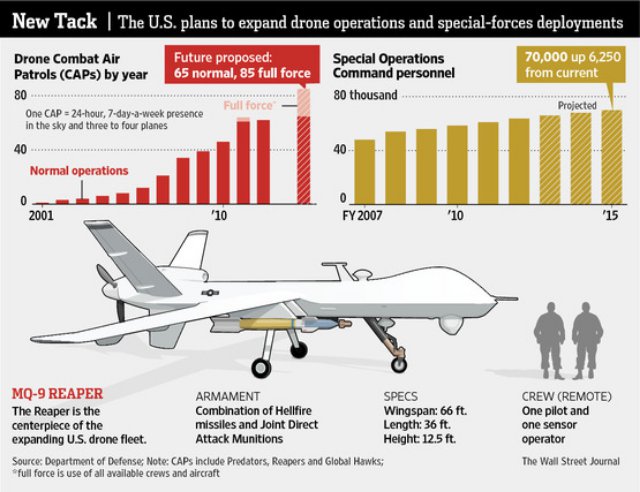The Pentagon plans to expand its global network of unmanned aircraft and special-operations bases in a fundamental realignment meant to project US power even as it cuts back conventional forces.
The plan, to be unveiled by Defense Secretary Leon Panetta on Thursday and in budget documents next month, calls for a 30% increase in the U.S. fleet of armed unmanned aircraft in the coming years, defense officials said.
The strategy reflects the Obama administration’s increasing focus on small, secret operations in place of larger wars.
Marines, for example, will use a new base in Darwin, Australia, as a launch pad for Southeast Asia, while the U.S. is in talks to expand the U.S. presence in the Philippines—potential signals to China that the U.S. has quick-response capability in its backyard, defense officials said.
The Pentagon, meanwhile, sees the bases and unmanned aircraft as part of an effort to offset cutbacks that some critics say will undercut the U.S.’ global dominance. The Pentagon says it will have more than enough force to fight at least one major troop-intensive ground war.
Mr. Panetta alluded in a speech on Friday to plans to invest more heavily in unmanned aircraft and special forces, saying the U.S. wanted to develop an “innovative rotational presence” in Latin America, Africa and elsewhere.
Mr. Panetta is scheduled to outline elements of the department’s $525 billion budget for fiscal 2013, including the first of $487 billion in cuts over 10 years, at the Pentagon Thursday.
The plan, however, envisions a 10% increase in special-operations forces over the next four years, from 63,750 this year to 70,000 by 2015, U.S. officials said. Mr. Panetta also will announce a buildup in the unmanned aircraft fleet in the coming years, U.S. officials said, following growth under predecessor Robert Gates.
The Air Force now operates 61 unmanned aircraft combat air patrols around the clock, with up to four aircraft in each patrol. Mr. Panetta’s plan calls for the military to have enough unmanned aircraft to comfortably operate 65 combat air patrols constantly with the ability to temporarily surge to 85 combat air patrols, officials said.
Source: The Wall Street Journal

